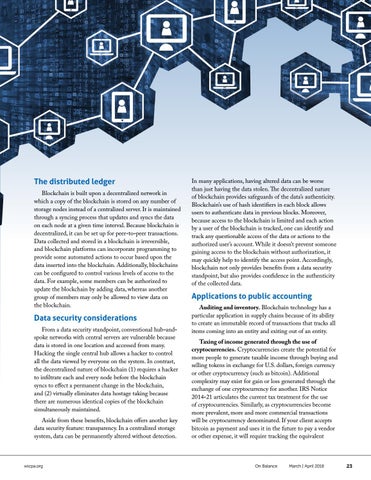The distributed ledger Blockchain is built upon a decentralized network in which a copy of the blockchain is stored on any number of storage nodes instead of a centralized server. It is maintained through a syncing process that updates and syncs the data on each node at a given time interval. Because blockchain is decentralized, it can be set up for peer-to-peer transactions. Data collected and stored in a blockchain is irreversible, and blockchain platforms can incorporate programming to provide some automated actions to occur based upon the data inserted into the blockchain. Additionally, blockchains can be configured to control various levels of access to the data. For example, some members can be authorized to update the blockchain by adding data, whereas another group of members may only be allowed to view data on the blockchain.
Data security considerations From a data security standpoint, conventional hub-andspoke networks with central servers are vulnerable because data is stored in one location and accessed from many. Hacking the single central hub allows a hacker to control all the data viewed by everyone on the system. In contrast, the decentralized nature of blockchain (1) requires a hacker to infiltrate each and every node before the blockchain syncs to effect a permanent change in the blockchain, and (2) virtually eliminates data hostage taking because there are numerous identical copies of the blockchain simultaneously maintained. Aside from these benefits, blockchain offers another key data security feature: transparency. In a centralized storage system, data can be permanently altered without detection.
wicpa.org
In many applications, having altered data can be worse than just having the data stolen. The decentralized nature of blockchain provides safeguards of the data’s authenticity. Blockchain’s use of hash identifiers in each block allows users to authenticate data in previous blocks. Moreover, because access to the blockchain is limited and each action by a user of the blockchain is tracked, one can identify and track any questionable access of the data or actions to the authorized user’s account. While it doesn’t prevent someone gaining access to the blockchain without authorization, it may quickly help to identify the access point. Accordingly, blockchain not only provides benefits from a data security standpoint, but also provides confidence in the authenticity of the collected data.
Applications to public accounting Auditing and inventory. Blockchain technology has a particular application in supply chains because of its ability to create an immutable record of transactions that tracks all items coming into an entity and exiting out of an entity. Taxing of income generated through the use of cryptocurrencies. Cryptocurrencies create the potential for more people to generate taxable income through buying and selling tokens in exchange for U.S. dollars, foreign currency or other cryptocurrency (such as bitcoin). Additional complexity may exist for gain or loss generated through the exchange of one cryptocurrency for another. IRS Notice 2014-21 articulates the current tax treatment for the use of cryptocurrencies. Similarly, as cryptocurrencies become more prevalent, more and more commercial transactions will be cryptocurrency denominated. If your client accepts bitcoin as payment and uses it in the future to pay a vendor or other expense, it will require tracking the equivalent
On Balance
March | April 2018
23
